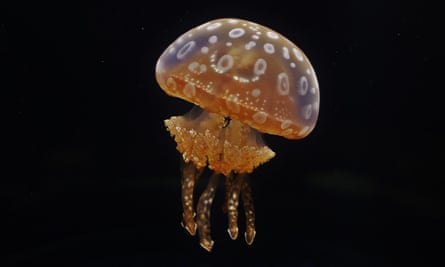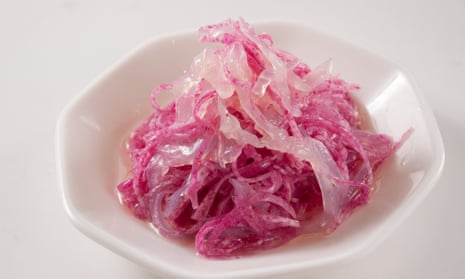The world has a jellyfish problem. In 2014, they invaded a Scottish salmon farm, killing 300,000 fish overnight. They have shut down power stations, incapacitated a US nuclear warship and had a significant socioeconomic impact on tourist areas. At the moment, a group of Australian scientists are researching the possibility that they will eventually utterly destroy all other life in the oceans.
The Guardian’s product and service reviews are independent and are in no way influenced by any advertiser or commercial initiative. We will earn a commission from the retailer if you buy something through an affiliate link. Learn more.
The answer? Cooking them, according to one Italian scientist. Stefano Piraino, a zoology professor at the University of Salento, is about to embark on a European commission-funded study to try to demonstrate that the ideal location for jellyfish is on our dinner tables.
“We need to adapt, to turn this problem into an opportunity,” says Piraino. “We started to analyse the chemical composition of jellyfish in the Mediterranean and realised that they were similar to the ones eaten in the far east. So we thought: ‘Why don’t we try to eat them?’”

If jellyfish were to become a regular option at your local chippy, one of the main advantages would be their hardiness. Even if you remove a jellyfish from the sea, it doesn’t stop new ones being born, as they spawn from polyps attached to the bottom of the ocean. So, unlike most fish, there’s no possibility of permanently damaging stocks. Or as Piraino puts it: “It’s a sustainable food source!”
Is it a delicious food source, though? Jellyfish is known for a delicate, slightly salty, flavour that means it’s eaten more as a textural experience. Its slimy, slightly chewy consistency means that Chinese and Japanese gourmands often eat it raw or sliced up as a salad ingredient. “I once had a Michelin-starred chef prepare a jellyfish tasting, and one fish expert said that it was like the best oyster he’d ever tasted,” says Piraino. “In Sardinia and Sicily, they take similar sea animals to the jellyfish, fry them up, and they’re a local delicacy. I think it will only be a matter of time until we’re widely adapted to eating them.”
Piraino isn’t alone: a slow food conference in Genoa featured a stall promoting fried jellyfish. The increasing demand for jellyfish from Chinese people living in Italy means that Asian exporters are already struggling to keep up.
“The opportunities are there and, ultimately, we need a better plan than to simply stay out of the water,” says Piraino. “We need to train fishermen so we can get some value from this unused biomass.” While some diners may still feel squeamish at the prospect of tucking into the gelatinous sea creatures, it sounds like Italy, at least, is ready for that jelly.

Comments (…)
Sign in or create your Guardian account to join the discussion